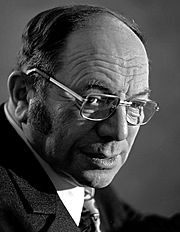Leonid Kantorovich facts for kids
Quick facts for kids
Leonid Kantorovich
Леони́д Канто́рович |
|
|---|---|

Leonid Kantorovich in 1975
|
|
| Born |
Leonid Vitalyevich Kantorovich
19 January 1912 |
| Died | 7 April 1986 (aged 74) |
| Resting place | Novodevichy Cemetery, Moscow |
| Nationality | Soviet |
| Alma mater | Leningrad State University |
| Known for | Linear programming Kantorovich theorem normed vector lattice (Kantorovich space) Kantorovich metric Kantorovich inequality approximation theory iterative methods functional analysis numerical analysis scientific computing |
| Awards | Sveriges Riksbank Prize in Economic Sciences in Memory of Alfred Nobel (1975) |
| Scientific career | |
| Fields | Mathematics |
| Institutions | USSR Academy of Sciences Leningrad State University |
| Doctoral advisor | Grigorii Fichtenholz Vladimir Smirnov |
| Doctoral students | Svetlozar Rachev Gennadii Rubinstein |
| Academic career | |
| Information at IDEAS / RePEc | |
Leonid Vitalyevich Kantorovich (Russian: Леони́д Вита́льевич Канторо́вич, IPA: [lʲɪɐˈnʲit vʲɪˈtalʲjɪvʲɪtɕ kəntɐˈrovʲɪtɕ]; 19 January 1912 – 7 April 1986) was a brilliant Soviet mathematician and economist. He is famous for creating a special math method called linear programming. This method helps figure out the best way to use limited resources.
Kantorovich won the Stalin Prize in 1949. Later, in 1975, he received the Nobel Memorial Prize in Economic Sciences. This award recognized his important work on how to use resources in the best possible way.
Contents
The Life of Leonid Kantorovich
Leonid Kantorovich was born on January 19, 1912, in Saint Petersburg, Russia. His family was Jewish, and his father was a doctor. Leonid was a very smart kid.
Early Studies and Becoming a Professor
In 1926, when he was just 14 years old, Leonid started studying at Leningrad State University. He focused on math and mechanics. By 1930, he had finished his main studies and began working on his advanced degrees. Amazingly, by 1934, at only 22 years old, he became a full professor at the university!
Solving Real-World Problems with Math
Kantorovich later worked for the Soviet government. He was asked to help a plywood factory make its production better. To do this, he invented a new mathematical technique in 1939. This technique is now known as linear programming. It helps find the most efficient way to do things when you have limited supplies or time.
He wrote several important books about his ideas. These included The Mathematical Method of Production Planning and Organization (1939) and The Best Uses of Economic Resources (1959). His work was so important that he received the Stalin Prize in 1949.
Hero During the Siege of Leningrad
After 1939, Kantorovich became a professor at the Military Engineering-Technical University. During World War II, the city of Leningrad (now Saint Petersburg) was under a terrible attack called the Siege of Leningrad. Food and supplies had to be brought into the city across a frozen lake, Lake Ladoga. This route was known as the "Road of Life."
Kantorovich used his math skills to help. He calculated the safest distance between trucks driving on the ice. This depended on how thick the ice was and how cold the air was. In the winter of 1941-1942, he even walked on the ice himself to make sure the trucks wouldn't sink. Sadly, many trucks were still destroyed by German attacks. For his bravery and contributions, he received the Order of the Patriotic War and the medal For Defense of Leningrad.
Later Life and Nobel Prize
After the war, in 1948, Kantorovich was involved in the USSR's atomic project. In 1960, he moved to Novosibirsk. There, he started and led the Department of Computational Mathematics at Novosibirsk State University.
In 1975, Leonid Kantorovich shared the Nobel Memorial Prize with another economist, Tjalling Koopmans. They won the prize "for their contributions to the theory of optimum allocation of resources." This means their work helped us understand how to use resources in the best possible way to get the most out of them.
Images for kids
See also
 In Spanish: Leonid Kantoróvich para niños
In Spanish: Leonid Kantoróvich para niños
- List of Russian mathematicians
- List of economists
- Shadow price




